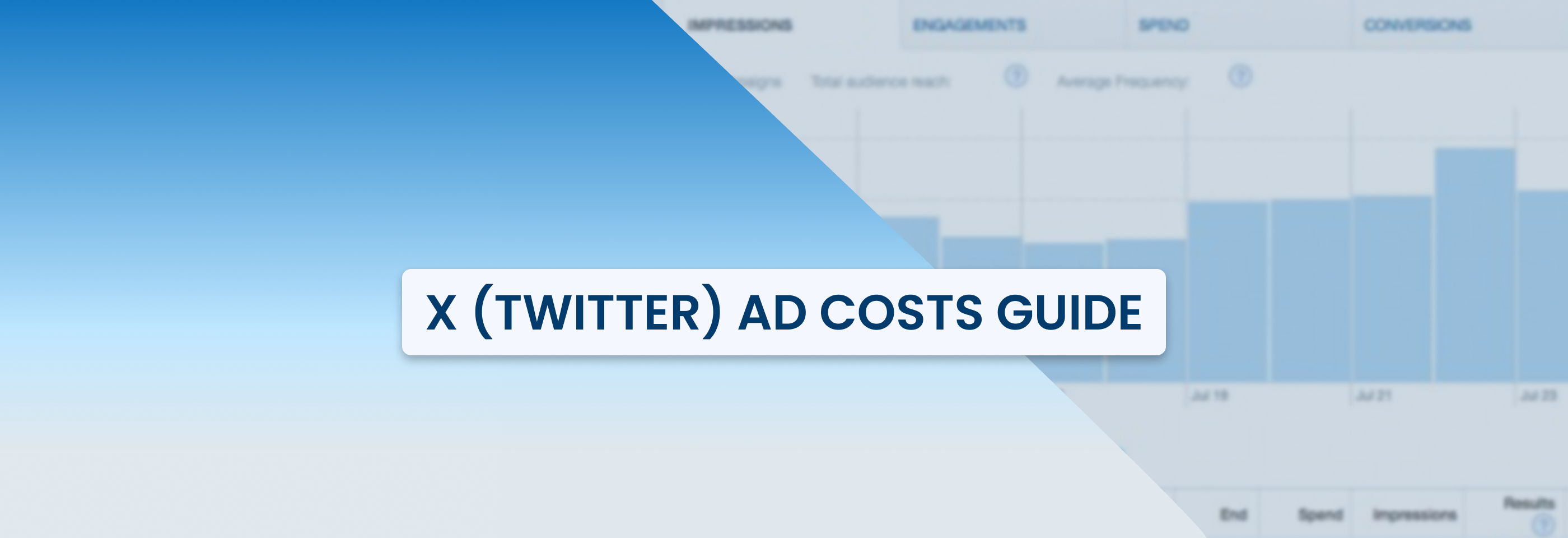How Much Does a Facebook Ad Cost? A Comprehensive Guide
2024-04-23
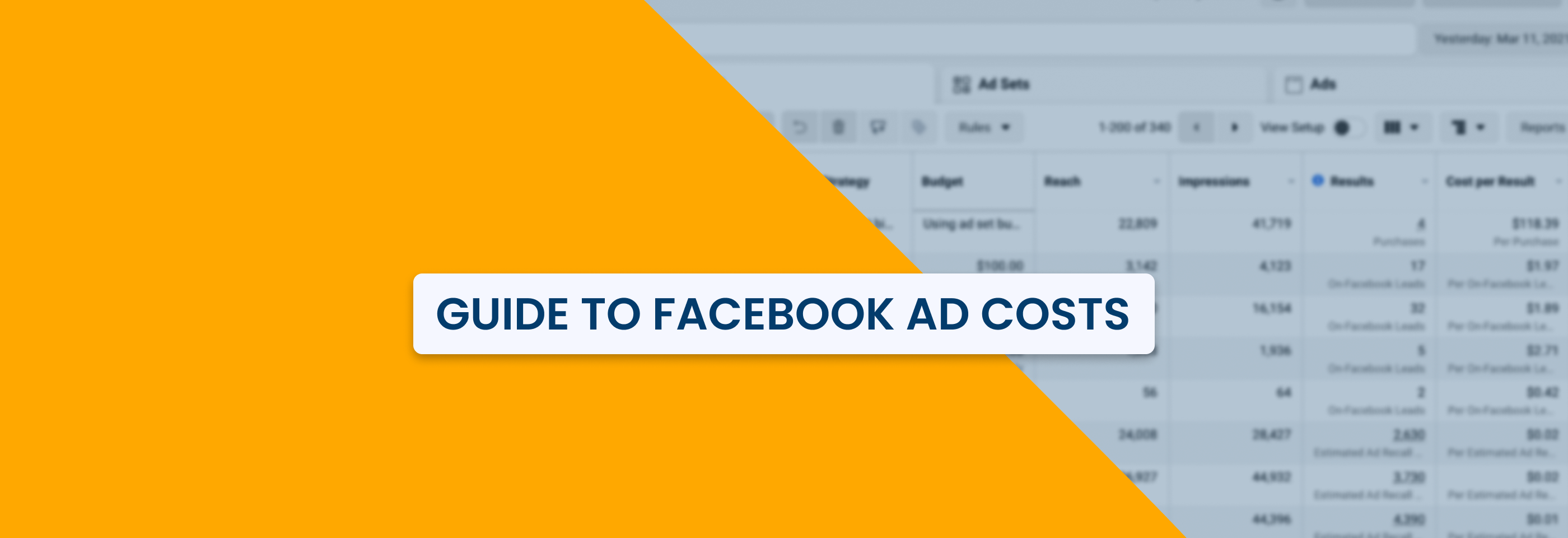
Determining the cost of Facebook ads can be like solving a riddle. It’s not as simple as paying a fixed price – costs depend on many variables, and you have to understand them if you want to spend your money wisely.
In this guide, we'll go over everything that affects the cost of running Facebook ads. By the end of this article, you’ll have a better understanding of Facebook ad pricing and how to effectively manage your ad spend.
Let’s jump right into it and start with what interests most advertisers – the numbers.
How much do Facebook ads cost?
The costs of Facebook ads can vary widely based on multiple factors. Generally, you can expect to pay anywhere from a few cents to several dollars per click or impression.
When it comes to average ad spend, WebFX's study reveals that nearly half of the advertisers spend between $51 to $500 monthly on Facebook ads, with the remaining advertisers spending less (between $1 to $50) or more ($501 to $3000 and higher). Over 75% of advertisers pay no more than $2 per click and no more than $10 per 1,000 impressions, with 81% expressing satisfaction with their Facebook ROI.
Moreover, Meta's report from Q3 of 2023 highlights a 31% increase in ad impressions on Facebook year-over-year, coupled with a 6% decrease in the average price per ad over the same period.
These statistics paint a pretty positive picture, and if we do everything right, we also have a chance of getting good results while keeping our ads cost-effective. That’s why it’s crucial to not just check the average numbers but also understand what factors determine the costs of Facebook ads.
9 things that influence Facebook ad costs
1. Industry
Statistics show that some industries have tougher competition in online advertising, which affects how much they spend on ads. For instance, industries like retail, consumer packaged goods, and financial services spend more on advertising than all the others according to eMarketer’s report on US Digital Ad Spending in 2023.
WordStream's research demonstrates that the average cost-per-click (CPC) and cost-per-lead (CPL) vary a lot between the industries based on the type of products or services they advertise: from CPC of $0.87 and CPL of $13.46 for the Arts & Entertainment industry to $5.42 and $78.26 respectively for Legal Services sector.
If your product is pricey or leads are harder to generate in your niche, you’ll likely pay more for ads. The baseline is that you have to understand what you’re in for when you start running your Facebook ads.
2. Country
Advertising expenses also change a lot depending on which country you're in.
Countries with more Facebook users might have more advertisers competing for space, which makes the costs go up. Also, in richer countries where people spend more money, ads usually cost more because advertisers want to reach those customers.
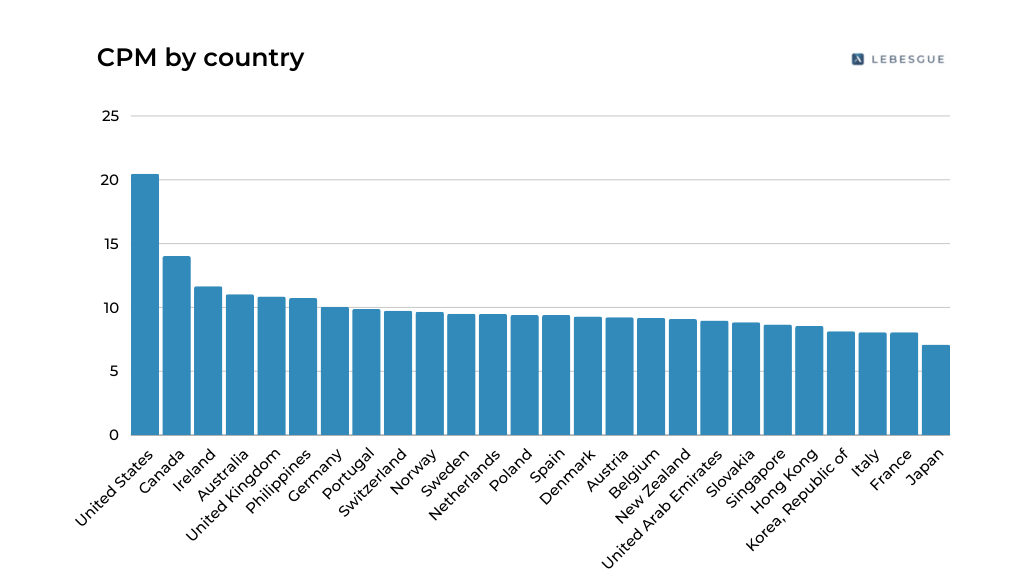
Source: Lebesgue
This is supported by multiple statistics that show, for example, that advertising in the United States or Europe will cost you more than if you run your ads in Asian or Latin American countries.
3. Target audience
When you’re competing for ad space, you’re not just competing against other businesses like yours – you’re competing with other businesses from different industries.
If a lot of advertisers want to reach the same demographic as yours, you could find yourself locked into a bidding war that’s more expensive than ever. Custom audiences also typically cost more than regular audiences.
In short, your audience will most definitely affect how much you spend on ads.
4. Campaign objective and performance goals
Facebook offers different ad objectives: making people aware of your brand, getting more visitors to your website, making people buy something, and so on. Your choice of what you want your ads to achieve affects how Facebook shows your ads and how much you spend.
Some goals will cost more than others: it’s more expensive to get someone to buy your products compared to just getting them to visit a page. That’s why picking the right goal is key to getting the most out of your money on Facebook ads.
5. Ad placements
If many businesses want the same spot for their ads, the price will predictably go up – that’s why you’ll have to pay more to show your ads on certain placements versus others.
For instance, Instagram has the highest cost per click (CPC) compared to other places for Facebook ads. According to WebFX, businesses pay an extra $0.80 for each click on Instagram and $0.78 more for ads on Instagram Stories on average.
Ads on Facebook itself, including Facebook Messenger, have a lower average CPC, about $0.30 less than on Instagram.
The Audience Network has an even lower CPC than Facebook and Instagram. Typically, businesses pay around $0.20 more per click than the average cost for Facebook ads. 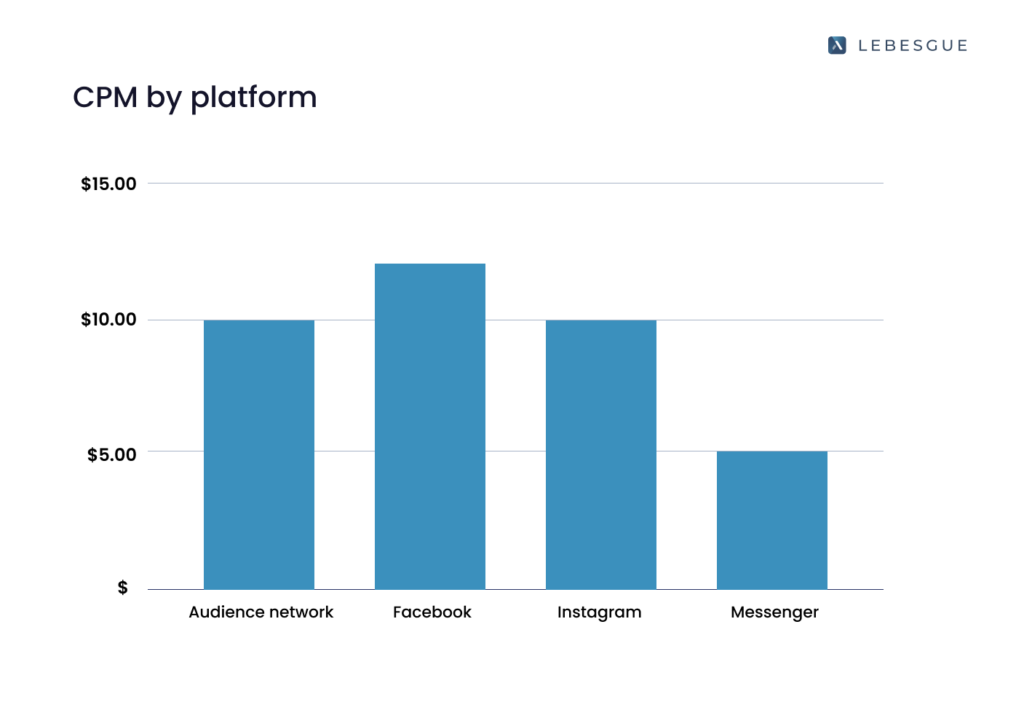
Source: Lebesgue
Knowing these differences can help you choose the most cost-effective options to display your ads.
6. Relevance and quality
Facebook uses an auction to decide which ads get shown to people and rewards good ads with lower prices and better positions.
The relevance score assigned by Facebook to each ad with more than 500 impressions tells you how well your ad is doing with your audience. The higher your relevance score, the cheaper your ads will be.
7. Timing and seasonality
Facebook ad costs often drastically change depending on the time of the year. For example, the prices can go up a lot during big shopping days like Black Friday or Cyber Monday, holidays like Thanksgiving, Christmas, New Year’s Eve, and so on.
The same is true for the days of the week and the hours of the day. When people are more active on Facebook, ads tend to cost more – there is more competition. When people are less active, ads tend to be cheaper because there are fewer businesses advertising.
Keep in mind, however, that even though ads may be cheaper during these quieter times, there are fewer people on Facebook and you may not reach enough of them to achieve certain goals.
8. Bidding strategy
Your bidding approach affects your ad spend, budget allocation, and optimization priorities. If your ad receives a perfect rating in Facebook's rating system, you win the offer.
However, if you bid too aggressively, your cost per conversion might go up. That’s why choosing the right strategy is essential for managing costs effectively and achieving your advertising objectives.
9. Ad budget
The type of budget you choose affects how you spend money on ads over time, how they’re allocated across different ad sets, and how effectively your ads perform.
The wrong budget type can lead to poor ad performance, resulting in higher costs, so make sure you pick wisely.
Now that we’ve gone through all the factors that can influence the costs of your Facebook ads, it’s time to consider how Facebook decides how much you’ll need to pay.
How Facebook ad auction works
The first thing you need to know about Facebook’s ad pricing mechanism is that it relies on an ad auction to determine which ads are shown to users. Essentially, it’s a contest to determine which ad will be shown to users when they use Facebook or any of the other apps.
But how does Facebook determine who gets to compete in each ad auction?
Mainly, Facebook looks at the target audience that advertisers specify for their ads. It’s also important to remember that a single person can be part of several target audiences. For example, one advertiser may want to target people who love gardening, while another could target people living in a particular city, such as New York. A gardening fan from NYC will fall into both categories, and the competition for their attention will begin.
Facebook takes these things into account when picking the auction winner:
- How much the advertiser is willing to pay (the bid);
- How likely it is that someone will engage with or buy something from the ad (estimated action rates);
- How good the ad is (ad quality), based on things like feedback and whether it's seen as low-quality according to Facebook’s ad quality standards.
The winning ad combines the best of both worlds – it provides maximum value for both users and advertisers.
Remember that Facebook values ad quality and expected action rates more than bid amounts: a more relevant ad may outperform one with a higher bid. You can use ad relevance diagnostics to check if your ads are relevant to the people you’re targeting.
That being said, you shouldn’t make getting top ad relevance rankings more important than it actually is – even if your ad gets a high score, it doesn't mean you'll automatically get better results.
Rather than focusing on quality ranking, pay attention to your advertising goals and how your ads help you meet them. If your ads are already doing well in this regard, you might not need to check ad relevance diagnostics that often. And even if your ads have lower rankings in ad relevance diagnostics, it's okay as long as they’re working for you.
Also, no matter what, Facebook won't charge you more than what you’re prepared to spend, i.e. your bid. Facebook also allows you to manage your ad spending through setting budget and cost controls (more on that later).
Now it’s time to learn how Facebook charges advertisers for their ads.
Understanding Facebook ad pricing models
Most advertising platforms, including Facebook, use two basic pricing models: CPC (Cost Per Click) and CPM (Cost Per Mille). Knowing which one to choose will help you get the most out of your ad budget.
What is Cost Per Click (CPC)?
Cost Per Click (CPC) model means that advertisers pay for each click their ad receives.
Here's how to calculate CPC: 
For example, if you spend $100 on an ad and it receives 50 clicks, each click on your ad will cost you $2 ($100 divided by 50 clicks).
What is Cost Per Mille (CPM)?
Cost Per Mille (CPM), or cost per thousand impressions, means that advertisers pay for every 1,000 impressions or views of their ad.
Here's how to calculate CPM:
For example, if you spend $200 on an ad that receives 50,000 impressions, you’ll pay $4 for a thousand impressions ($200 / 50,000 * 1,000).
CPC or CPM: what to choose?
Basically, your choice will depend on what you want to achieve with your ads.
CPC is typically used when the primary goal of the ad campaign is to get people to visit a website, fill out a form, or do something specific. It's good if you only want to pay when someone interacts with your ad by clicking on it (which can turn into a conversion later), not just seeing it.
CPM, on the other hand, is mainly used when the primary goal of the advertising campaign is to increase brand awareness or reach a large audience. You can use it if you want to maximize ad exposure and get as many people to see them even if they don’t end up clicking – it’s all about visibility and brand awareness.
Key takeaway: take into account factors such as your campaign goals (what actions do you want users to take?), target audience (is it a cold or a warm audience?), and budget allocation (what’s the most cost-effective model for you?).
Other metrics for calculating Facebook ad costs
Besides CPC and CPM, other cost metrics might also help you check your ads for cost efficiency. There are no corresponding pricing models on Facebook for these metrics, but it’s still a good idea to track them for a clearer picture of ad performance.
Cost per engagement
Cost per engagement measures the cost of each interaction with an ad – likes, comments, shares, or clicks. It helps you check how engaging your ads are and whether they're effectively capturing the attention of your target audience.
Here’s the formula for cost per engagement:
For example, if you spent $50 on an ad campaign and it got 500 engagements, the cost per engagement would be $50 / 500 = $0.10 per engagement.
Cost per lead
If you want to know how much you’re spending on each lead generated and how your ads are performing in terms of generating leads, try calculating CPL or cost per lead.
Here’s the formula for CPL:
For example, if you spent $100 on an ad campaign and it generated 20 leads, the cost per lead would be $100 / 20 = $5 per lead.
Conversion rate
Conversion rate is the percentage of people that click on an ad and take a desired action – such as making a purchase, subscribing to a newsletter, or completing a form. It’s a measure of how effective an ad is at generating real business outcomes.
By tracking it, you can identify which ads or audiences drive more conversions and allocate more budget to them.
Here’s how to calculate a conversion rate:
For example, if your ad received 1,000 clicks and generated 50 conversions, the conversion rate would be (50 / 1,000) * 100 = 5%.
Cost per install
If you’re running app promotion campaigns, measuring how much each install costs will help you determine the effectiveness of your ads and how relevant your app is to a specific audience segment.
You can calculate the cost per install this way:
For example, if you’ve spent $500 on your Facebook ad campaign that generated a total of 200 app installs, each install has cost you $2.50.
Besides knowing how Facebook ad pricing works, we also need to understand how to spend our ad budgets to keep the costs down.
Understanding Facebook ad bidding strategies
As we’ve explained earlier, every time you want to show your ad to someone on Facebook, it enters a competition with other ads. This makes it hard to know exactly how much your ad will cost.
However, Facebook offers several bidding strategies to choose from to control your spending.
Essentially, your bid strategy choice tells Facebook how to bid for you in ad auctions. Choosing the right bid strategy can help you achieve specific business goals, like increasing sales, getting more customers, or reaching more people with your brand.
There are three main bidding strategies: spend-based, goal-based, and manual bidding. Each strategy includes specific tactics to help you manage your budget based on your goals.
The goal of spend-based bidding is to use up your whole budget while getting as many results or as much value as possible. There are two ways to do so:
- Highest volume: it allows you to get as many conversions from your budget as possible. You can use this strategy if you don't have a specific CPA or any other performance goal, but keep in mind that your CPA can fluctuate because of this. If you're not worried about the possibility of spending more per action and want to get the most out of your budget, this strategy might be just right for you.
- Highest value: it helps you to get the most value from your leads, not just more conversions. With this strategy, Facebook will try to use your entire budget to get the highest value purchases. To use this strategy, you’ll need to qualify for value optimization and have a working Meta Pixel or SDK set up to track Conversion events.
Goal-based bidding sets a specific cost or value you want to achieve. There are two options:
- Cost per result goal: it helps you keep the average cost per action (CPA) steady, no matter what's happening in the market. Facebook will try to stick to the spending limit you set, but sometimes the cost per conversion may vary. With this strategy, Facebook doesn’t aim to spend your entire budget, so it might take longer to learn how your ads perform.
- ROAS (return on ad spend) goal: it allows you to maintain an average ROAS for the whole duration of your campaign. This can be a good choice if you care about meeting a specific ROAS number more than spending your full budget. Note that in this case, you also have to meet the eligibility requirements.
Manual bidding lets you control how much you bid across ad auctions. There's one option:
- Bid cap: it is perfect when you know how much you want to spend. You can decide the highest amount you're willing to pay for each ad auction, rather than letting Facebook decide based on your budget or goals. It's for advertisers who know how likely people are to take action on their ads and can figure out the best bid to make.
Choosing the right bidding strategy is just one part of spending your money wisely – you also have to set the ad budget that fits your goals.
Understanding different types of Facebook ad budgets
Just as bidding strategies impact how you spend on ads during auctions, the type of budget you choose determines how your overall ad spend is managed over time and how your money is used across different parts of your campaign.
Picking the wrong ad budget type could affect campaign performance, so you have to make the right choice.
There are two main types of Facebook ad budgets, and each of them comes with its own pros and cons.
Campaign budget
One of the options is to use a Meta Advantage campaign budget.
It works like this: instead of giving each ad set the same amount of money, Facebook handles an overarching campaign budget and decides how to spend it effectively across all of your ad sets.
This setup is great if you’re just starting your journey with Facebook ads. Basically, you set one main budget for all your ad sets, and Facebook's algorithm handles the rest. It spreads your money across different ad sets to maximize your results, i.e. allocates more budget to the most promising ad sets.
Here are the main benefits of using campaign budgets:
- They make campaign setup simpler;
- They reduce the number of ad sets you need to manage manually;
- They help you get the most out of your campaign budget;
- They work well for campaigns with lots of ad sets;
- They allow flexibility in how your budget is distributed across ad sets.
However, Facebook’s algorithm is not always the best judge when it comes to ad set performance: it might overlook ad sets that could bring future value and thus fail to allocate enough budget to them.
Ad set budget
On the other hand, when you choose an ad set budget, you can decide how much money goes to each ad set. It's a good choice if you already have experience with Facebook ads and are familiar with managing ad campaigns and analyzing different ad set metrics.
When you set the ad set budget, Facebook will try to spend the entire budget, regardless of how well the ads are performing in each ad set. This allows you to test different ads to see how they do – you can easily see which ad sets are doing well and which ones aren't, and then adjust the budget accordingly.
Ad set budgets also have their advantages:
- They give you more control over how money is spent within specific ad sets;
- They work well for campaigns with only a few ad sets;
- They’re useful when you have different optimization goals and bid strategies;
- They’re perfect for ad sets with big differences in audience size.
That being said, ad set budgets usually require constant monitoring and tweaking of bid strategies to ensure proper resource allocation.
These two types of ad budgets determine how you divide your money among ad sets. Now, let’s check the next two types that specify how each ad set will spend its budget over time.
Daily budget
For both campaign budgets and ad set budgets, you can choose to spend a specific amount of money daily. It's perfect if you want to keep the ad spend consistent every day to ensure stable results.
It’s fairly straightforward: you set a specific sum of money you want to spend each day based on your ad schedule and budget. Facebook will do its best to stick to this target.
Here are the perks of choosing a daily budget:
- It’s easier to control your spending;
- It works well for ongoing campaigns;
- It’s ideal for setting up campaigns that run continuously;
- It’s great for budgets that change regularly, like weekly, monthly, or quarterly budgets.
Keep in mind that Facebook is pretty flexible when it comes to spending your budget: it can end up spending up to 25% more than your daily budget on certain days if better performance opportunities arise.
If you want more consistency, consider the next type of budget instead.
Lifetime budget
A lifetime budget is basically the maximum amount of money you'll spend by the end of your ad campaign.
It works like this: you choose a start and end date for your campaign, and the amount spent each day will vary based on specific factors. Facebook's algorithm decides the best times to show your ads and spends more than the average daily budget if the ad performance for this day looks promising.
A lifetime budget comes with these benefits:
- It requires less hands-on management;
- It allows you to see the total cost of your campaign;
- It works great for ad scheduling.
However, daily spending with lifetime budgets can fluctuate – it’s harder to predict the outcomes. Also, adjusting the budget or changing the campaign’s end date can impact how Facebook spends your money.
As you can see, each type of budget has its own advantages and disadvantages, so you have to do some digging into all of them to choose the right option for your situation. 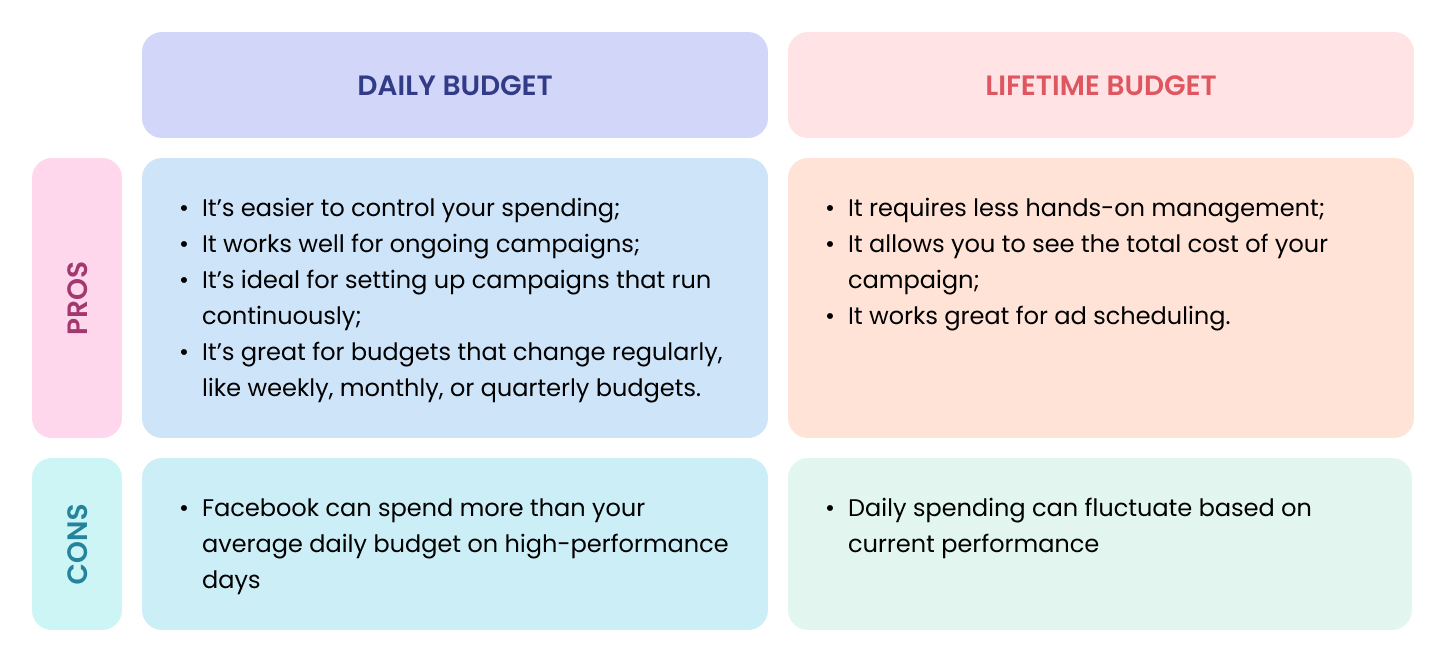
To choose the right type of ad budget for your Facebook ad campaigns, consider all of their pros and cons.
Last but not least, let’s consider the top tips on optimizing your Facebook ads cost and reducing your CPC and CPM.
Top tips for optimizing Facebook ad costs
1. Choose the right campaign objective and performance goal
Choosing the right campaign objective might seem like common advice, but it's crucial for saving money on your ads.
We’ve already mentioned that some campaign objectives will cost you more than others, so you have to pick the right one to let Facebook show your ads to the people most likely to take that action. This will help you reach the right audience and spend less money to get results.
To choose the right Facebook campaign objective, you should get clear on your advertising goals, consider the sales funnel stage of the people you’re targeting, evaluate audience behavior, and test different objectives to optimize ad performance.
2. Choose cost-effective placements for your ads
To lower the CPC or CPM of your Facebook ads, try choosing less costly ad placements with less competition for ad space.
You can consider factors like audience behavior, ad format suitability, and campaign objectives to pick the right placements. Then, you can test them and allocate your budget to placements that deliver the best results at the lowest cost.
3. Be specific with your target audience
To save money on Facebook ads, it might be a good idea to aim for a smaller and more specific audience interested in your product since Facebook values ad relevancy. However, don't make it too narrow – you might miss out on potential customers.
If you’re not sure whom you need to target, you can start broad to allow Facebook algorithms to find users most likely to convert. Then, you simply narrow down your targeting based on this data.
Also, consider excluding audience segments that aren’t that much of a good fit for your products or services – this can help you focus only on users who will find your offers relevant.
4. Lower your ad frequency score
Ad frequency is how many times people see your ad on average. If it's too high, they might get tired of seeing it and ignore it. This can make your ads more expensive, so you have to set some frequency thresholds you don’t want to go over.
To keep the ad frequency low, consider refreshing your ads regularly to keep them interesting. You can do that by rotating different ad creatives for the same audience. You can also set a limit on how often someone sees your ad.
5. A/B test different ad creatives and placements
A/B testing is one of the best ways to figure out what works best for your Facebook ad campaigns. You can test different ad visuals, copies, CTAs, as well as various ad placements to find the most cost-effective options.
By doing this, you can learn what your audience likes (which influences the ad auction outcomes) and improve your ads to get better results without spending a lot of money.
6. Improve the user experience on your landing pages
The part of the journey after users click on your ad also plays a role in how much you’ll spend on Facebook ads. If your website is slow or poorly designed, users will leave without converting, meaning you’ve wasted your ad spend on nothing.
To avoid this, optimize your landing pages and the website in general to make a good impression on your audience. This will make your ads work better and provide a higher ROI.
7. Run retargeting campaigns
Retargeting allows you to show your ads to people who have visited your website, liked your Facebook posts, or filled out a form online. In short, to those who have gone further down your sales funnel.
They're more likely to buy from you with the right incentive, which can make your ads cheaper.
The best advice here is to use Meta Pixel: this Facebook tool gathers info about visitors to your website and connects it to their Facebook profile. It tracks things like which pages they looked at, what they put in their cart, and how long they stayed.
Then, you can use this info to show personalized ads to these people and get more out of your advertising budget by targeting users.
Recap
In conclusion, understanding what influences Facebook ad costs can help you get the most out of your money. So far, we've talked about lots of things that affect ad prices, like how much competition there is in your industry and where you place your ads. We've also looked at different ways you can lower your CPC or CPM – you just have to try them to find what works for you.
By following these tips and keeping an eye on how your ads are doing, you can make sure you're spending your ad money wisely and getting good results on Facebook.

